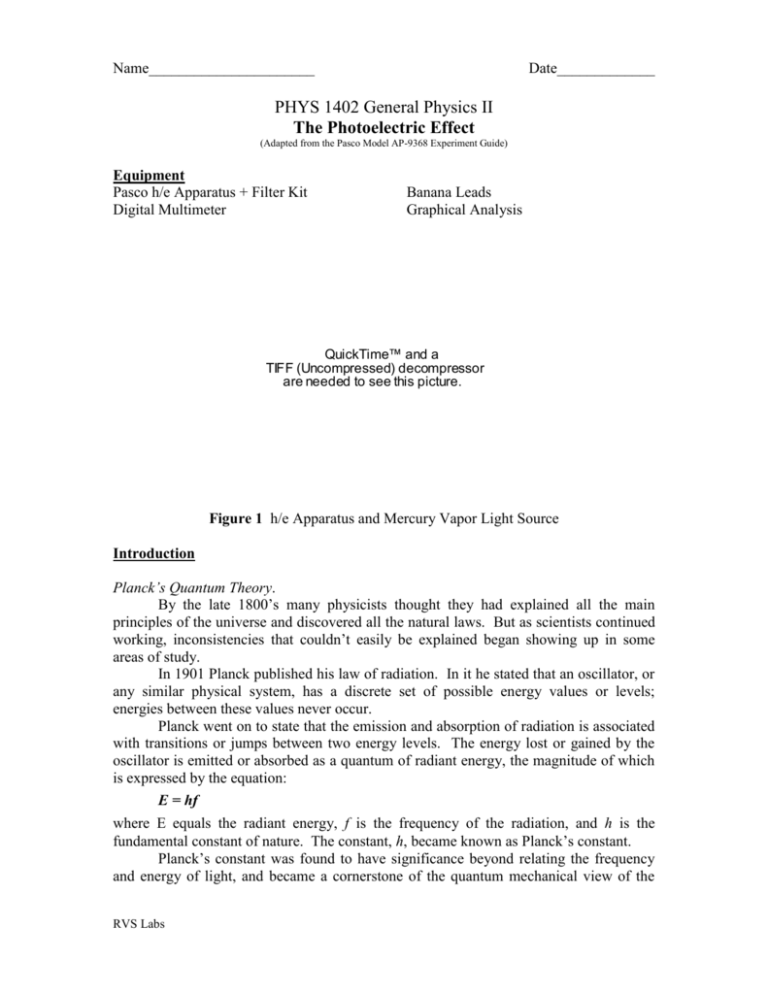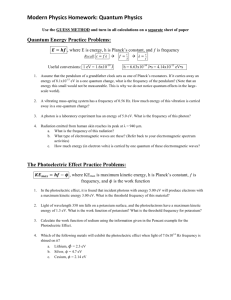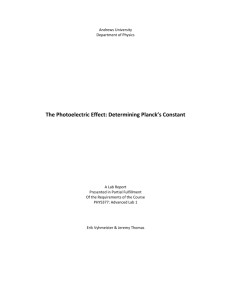The Photoelectric Effect
advertisement

Name______________________ Date_____________ PHYS 1402 General Physics II The Photoelectric Effect (Adapted from the Pasco Model AP-9368 Experiment Guide) Equipment Pasco h/e Apparatus + Filter Kit Digital Multimeter Banana Leads Graphical Analysis QuickTime™ and a TIFF (Uncompressed) decompressor are needed to see this picture. Figure 1 h/e Apparatus and Mercury Vapor Light Source Introduction Planck’s Quantum Theory. By the late 1800’s many physicists thought they had explained all the main principles of the universe and discovered all the natural laws. But as scientists continued working, inconsistencies that couldn’t easily be explained began showing up in some areas of study. In 1901 Planck published his law of radiation. In it he stated that an oscillator, or any similar physical system, has a discrete set of possible energy values or levels; energies between these values never occur. Planck went on to state that the emission and absorption of radiation is associated with transitions or jumps between two energy levels. The energy lost or gained by the oscillator is emitted or absorbed as a quantum of radiant energy, the magnitude of which is expressed by the equation: E = hfI where EIequals the radiant energy, f is the frequency of the radiation, and h is the fundamental constant of nature. The constant, h, became known as Planck’s constant. Planck’s constant was found to have significance beyond relating the frequency and energy of light, and became a cornerstone of the quantum mechanical view of the RVS Labs subatomic world. In 1918. Planck was awarded a Nobel Prize for introducing the quantum theory of light. The Photoelectric Effect. In photoelectric emission, light strikes a material, causing electrons to be emitted. The classical wave model predicted that as the intensity of incident light was increased, the amplitude and thus the energy of the wave would increase. This would then cause more energetic photoelectrons to be emitted. The new quantum model, however, predicted that higher frequency light would produce higher energy photoelectrons, independent of intensity, while increased intensity would only increase the number of electrons emitted (or photoelectric current). In the early 1900’s several investigators found that the kinetic energy of the photoelectrons was dependent on the wavelength, or frequency, and independent of intensity, while the magnitude of the photoelectric current, or number of electrons was dependent on the intensity as predicted by the quantum model. Einstein applied Planck’s theory and explained the photoelectric effect in terms of the quantum model using his famous equation for which he received the Nobel prize in 1921: E = hf = KEmax + WoI whereIKEmax is the maximum kinetic energy of the emitted photoelectrons, and Wo is the energy needed to remove them from the surface of the material (the work function). E is the energy supplied by the quantum of light known as the photon. The h/e Experiment. A light photon with energy hf is incident upon an electron in the cathode of a vacuum tube. The electron uses a minimum Wo of its energy to escape the cathode, leaving it with a maximum energy of KEmax in the form of kinetic energy. Normally the emitted electrons reach the anode of the tube, and can be measured as a photoelectric current. However, by applying a reverse potential V between the anode and the cathode, the photoelectric current can be stopped. KEmax can be determined by measuring the minimum reverse potential needed to stop the photoelectrons and reduce the photoelectric current to zero.* Relating kinetic energy to stopping potential gives the equation: KEmax = VeI Therefore, using Einstein’s equation, I Hv = Ve + WoI When solved forIV, the equation becomes: V = (h/e) f – (Wo / e ) I If we plotIV vs. f for different frequencies of light, the graph will look like Figure 2. The V intercept is equal to -Wo/e and the slope is h/e. Coupling our experimental determination of the ratio h/e with the accepted value for e, 1.602*10-19 coulombs, we can determine Planck’s constant, h. RVS Labs QuickTime™ and a TIFF (Uncompressed) decompressor are needed to see this picture. QuickTime™ and a TIFF (Uncompressed) decompressor are needed to see this picture. Figure 2 The graph of V vs. f Procedure 1. Make sure the room is darkened. 2. Assemble the apparatus as shown and tighten all brackets. Turn on the lamp and let it warm up for 10 minutes. QuickTime™ and a TIFF (Uncompressed) decompressor are needed to see this picture. QuickTime™ and a TIFF (Uncompressed) decompressor are needed to see this picture. 3. Test the battery and make sure it is at least 6 volts. To check the batteries, use a voltmeter to measure between the OUTPUT ground terminal and each BATTERY TEST terminal (-6V MIN and +6V MIN). If either battery tests below its minimum rating, it should be replaced before running experiments. Batteries functioning below the recommended minimum operating level of 6 volts may cause erroneous results in your experiments. 4. Rotate the detector with the coupling bar to the side with the brightest pattern on the screen. 5. Connect the voltmeter to the red and black terminals on the detector. Turn on the detector. 6. Open the light shield (cylinder behind the screen) on the detector and center one color on the screen. Rotate the detector so the same color passes throught both the inner an outer slits and tighten the thumbscrew on the support rod under the detector. 7. Press the zero button and record a voltage for each color. 8. Use yellow and green filters respectively for each yellow and green color to block out UV. You can “see” the UV because the material is made of a fluorescent material. The filter frames have magnetic strips and mount to the outside of the White Reflective Mask of the h/e Apparatus. Use the green and yellow filters when you’re using the green and yellow spectral lines. These filters limit higher RVS Labs frequencies of light from entering the h/e Apparatus. This prevents ambient room light from interfering with the lower energy yellow and green light and masking the true results. It also blocks the higher frequency ultraviolet light from the higher order spectra which may overlap with lower orders of yellow and green. 9. Plot Voltage vs. frequency and find the slope h/e and compare to the actual value. Data Table Color Yellow Wavelength 579 nm Frequency 5.19x1014 Green 546 nm 5.49x1014 Blue 436 nm 6.88x1014 Violet 405 nm 7.41x1014 Ultraviolet 365 nm 8.22x1014 V (Volts) e = 1.60 x 10-19 C h = 6.63 x 10-34 J۰s 10. slope x 10 = ___________x 10-15 = h/e experimental 11. Compare h/e to the accepted value of 4.14 x 10-15: % error = __________ QuickTime™ and a TIFF (Uncompressed) decompressor are needed to see this picture. RVS Labs










